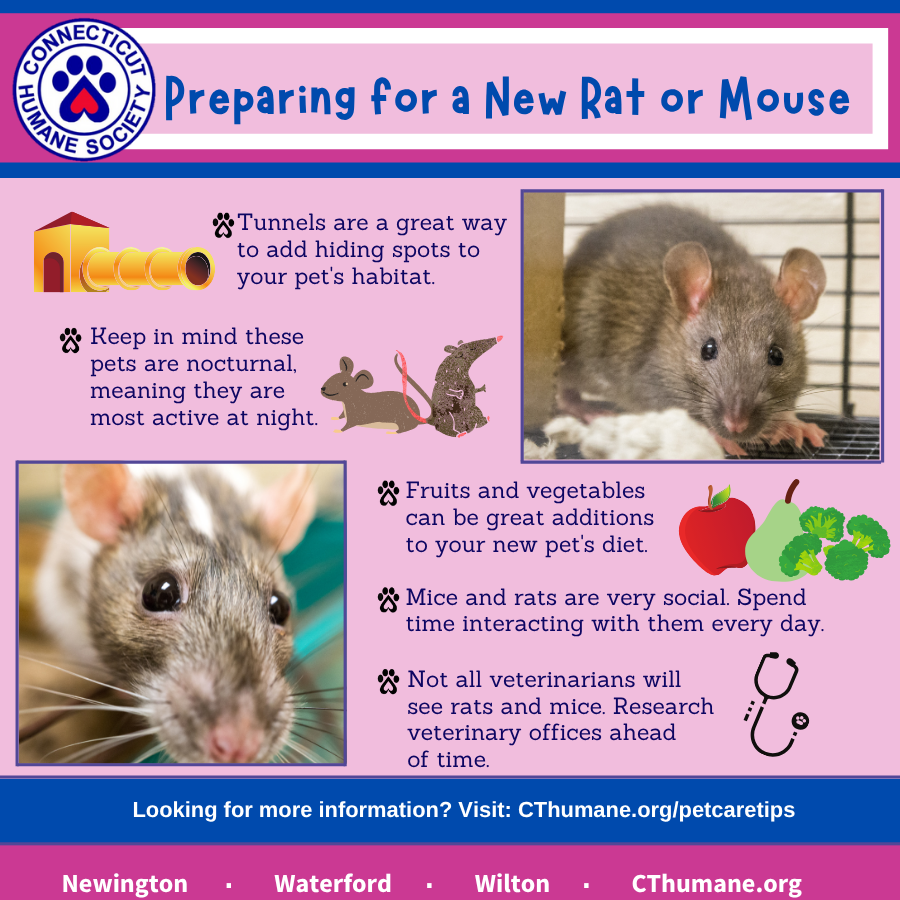
“What pet should I get?” It’s not just the title of a Dr. Suess book, it’s a question often heard from a first-time visitor to the Connecticut Humane Society. You’ve already thought about the pros and cons and whether or not you’re ready to get a pet, but you still might be on the fence about what type of pet you want. Or maybe you just adopted a pet, and you want to make sure you’ve covered all your bases. Check out these tips to start.
They’re affectionate, super smart, and did we mention clean? Rats and mice make great pets. Not only are they fascinating to watch, but they form close bonds with their people… and they’re trainable!
Basic Information
Average adult size:
Mice: 3 inches long, head to end of tail
Rats: 8 inches long, head to end of tail
Average life span:
Mice: 2 to 3 years with proper care
Rats: 2 to 3 years with proper care
- Rats and mice can be kept in same sex pairs or small groups if kept together from an early age. They can be kept individually but will require much more human interaction. If males and females are kept together, breeding or fighting may occur.
- They are primarily nocturnal (active during the night and sleep during the day). However, they are very social and can adapt to your schedule.
- Always wash your hands after handling your pet, or cleaning its dishes, cage, toys, etc.
Diet and Feeding
- Fresh food and water should always be available and changed daily. Most rats and mice are accustomed to drinking from a water bottle.
- Specialized pellets or lab blocks should make up 90% of their diet, along with small amounts of fresh vegetables, fruits, and timothy hay. Many are used to a seed-heavy diet. They should be transitioned gradually onto a pellet food.
- Vegetables and fruits not eaten within a few hours should be discarded.
- Do not feed avocado, citrus fruits, chocolate, caffeine or alcohol as these can cause serious medical conditions. Avoid sugar and high-fat treats.
Housing
- Rats and mice acclimate well to average household temperatures, not above 80°F. Avoid extreme temperature changes. The habitat should be placed off the floor in an area that is away from drafts.
- The habitat should be plastic, metal, or glass with an escape proof solid bottom. It is best to provide the largest habitat possible. At a minimum, a pair of rats should have a habitat 24”W x 24”D x 24”H.
- 1-2” of paper bedding, such as Carefresh, is recommended. Wood shavings should not be used.
- Clean and disinfect the habitat and non-porous toys regularly; remove wet spots daily and change bedding at least once a week or more often if necessary.
- They should also be given toys to tunnel through and hide in.
Training and Enrichment
- Gentle and rewards-based handling will help build and strengthen your bond with your new rat/mouse, and even train them!
- Provide a variety of chewable toys to promote proper teeth wear as rodent’s teeth grow continuously throughout their life.
Health and Veterinary Care
Healthy rats and mice have a nice fur coat and clear eyes, and are active, alert and sociable, eating and drinking often. A pet that is inactive, losing weight, has diarrhea, hair loss, or distressed breathing may be sick. If you notice these signs, discharge from the eyes or nose, or other problems, please see your veterinarian right away.
